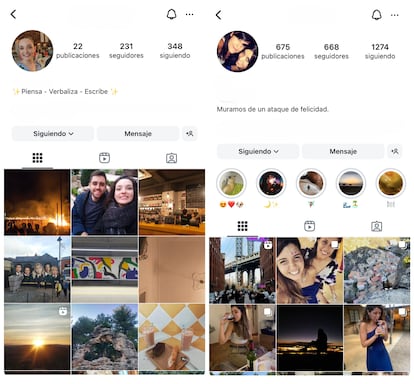


On Instagram, only one photo of the many that can be taken on the beach is published, which is a success on social networks. The stories in this app only show 15 seconds of the 24 hours of a day. Of all the trends that appear on TikTok the most popular dance of the week is performed. And the comments and opinions on the latest debate of the moment are reduced to a meme or 280 characters in X. All this for one purpose: to create and consolidate a profile on social networks. Or, in other words, building a digital identity that constantly adapts to the changes of a world on-lineunpredictable and ephemeral. This requires constant use of social networks to inhabit it, and can lead to problems such as the distortion of real identity in favor of the digital one, feelings of loneliness and the erosion of self-esteem due to constant comparison.
Young people are chronically connected because Instagram, TikTok, YouTube or X have become for them centennials (born between 1995 and 2009) and alpha (from 2010 onwards) in the non-place where things happen. They talk and connect with people who are not in the same physical space, they share what is happening at that moment while witnessing it and learning, in less than a minute, about new and ephemeral fashions. For these generations — 98.9% have a personal profile on social networks and use it daily, according to the study Digital leisure. Social networks, prepared by the Fad Juventud foundation with data from 2023—, consume content on-line and creating it is the new way of socializing and forming self-conception. Those who have grown up with the least face-to-face interaction in history are guided by the following: if you are not connected, you neither belong nor are.
“At first, I didn’t want to create a profile on Instagram but, when I was 15, I did it due to social pressure,” says Candela (she prefers not to give her last name) in a conversation with EL PAÍS. Now, at 24 years old, he logs into the social network at least three times a day. “I check the stories and, if I have time, I see the posts or the reels. I also respond to some direct messages.” In his daily routine, looking at social media, despite the fact that he makes one or two posts a year on Instagram, plays an important role: “They help me clear my head and give me that daily dose of dopamine.”
In her experience as a user of social networks, some patterns common to many stand out. When he was younger he felt the pressure of constantly managing his virtual image on Instagram. Now he recognizes that, on these platforms, he tries not to disguise who he is although “sometimes it is inevitable.” In moments of transition between new and old friendships, she felt alone and isolated “being at home and seeing how other people were enjoying seemingly perfect friendships.” And although he is not aware of what the content creators he follows publish daily, he does, in his words, “on occasion I have compared myself to people who show more luxurious, varied or happy lives.” Their reality is not alien to that of many young people who suffer, or suffered, identity problems, loneliness and self-esteem due to the massive use of networks.
The diffusion of the boundaries between real and digital identity
Personal profiles on Instagram, TikTok or X are a person’s letter of introduction. A selection of my own photos, tweets that summarize a social problem whose depth cannot be glimpsed, a reel with the latest readings of the month, a story to brag about the latest weekend plan or a meme that encompasses an entire population niche. The objective pursued with content creation is clear: show the world who a person is or who they want to be. However, this dichotomy can sometimes blur the boundaries between real and digital identity, favoring the latter.

The essayist NS Lyons, responsible for the popular newsletter The Upheaval in which he explores the cultural, technological and political changes in our era, he summarized it as follows in a conversation with the writer Freya India in his newsletter Girls: “Social networks reduce us to identity labels or consumer preferences. And both pigeonhole us into closed categories. What really matters—our character, our virtues, or how we treat people—is not something that can be shown on-line easily”.
An example of this submission of real identity to a pattern of social networks is the ascription to the concept Thought Daughter (whose translation could be something like the thinking daughter) among young girls on TikTok. This aesthetic encompasses those hypersensitive women who read classics, write diaries, listen to Lana del Rey and have a tendency to daydream, according to the video. The rise of the Thought Daughter: reading aesthetics of femcel rebrand?, from the account According to Alina. On the digital platform, videos of girls claiming that they are Thought Daughtera common identity created in social networks that crosses virtual borders.
In the profiles of the digital platforms, a person —adapted to new and ephemeral fashions— based on sharing small doses of real life and ascribed to causes or labels that encompass characteristics common to a gender or personality traits. This means that identities, increasingly among young women, are something that must be managed mainly on social networks in an obsessive and constant manner. Which fosters the development of an individualistic society with a tendency toward loneliness.
The contradiction of social networks: being constantly accompanied, but being alone
The use of social networks has led to a strong tendency towards individualism and a consequent isolation — 34.6% of young people between 18 and 24 years old suffer from unwanted loneliness, according to the latest barometer from the ONCE foundation and AXA. Because each profile represents an individual who is the protagonist at all times. Because from the sofa in your home you can access any space in the world. Because all users share how they feel, what they like or their ideas, avoiding the difficulties of face-to-face interactions. And because networks demand constant attention to what is happening in the world on-line in favor of the real.
This extreme individuality results in a feeling of loneliness despite the fact that, apparently, each person is constantly accompanied on social networks. It is illustrated with an example that is not foreign to many young people: sometimes, the main concern during a concert, a trip or a meeting with friends is how to take a photo or record a video so that it has a greater impact on social networks and then be pending reactions obsessively. Eva Molero, psychologist and psychotherapist expert in youth, child and family therapy, explains the reason behind this ulterior motive: “We want other people to see that I am having a good time, that I relate, that I have gone to the trendy place. And, all of this comes from the need for approval.”

Furthermore, this encourages, according to Alejandro Gómez, sociologist at the Fad Juventud foundation, the formation of weaker social and community ties built on a generalized feeling of loneliness. “It’s no longer about getting together in the park with my friend to chat. Now it’s getting together in the park with my friend to chat on the cell phone with another person.” Therefore, what social networks hide is an illusion: apparently, you have many people around you to help you and keep you company but, in reality, you are alone.
The condemnation of our lives because they are not like those on Instagram
The social media industry relies on constant comparison. Travel to a tropical paradise in the middle of winter. Tour for an apartment in the center of a gentrified capital with skyrocketing rents. Or a outfit composed with the latest collection of a brand that is not available to the middle class. Young people face, in a developed daily life on-lineto a constant bombardment of what they are not and what they do not have. All this ends up causing a detriment to self-esteem by not being able to achieve the lives that they deserve. influencers show on their profiles. “A teenager thinks that a person with two million followers on Instagram leads a normal life and can be like her,” Gómez begins. “Also, since he has followers and likes, “You have to be that or you’re not okay.”
Social networks have favored the construction of a very specific type of reference: a person whose job is to create content and advertise on their different profiles and who shows a reality far removed from what a teenager can achieve. Molero explains this situation like this: “People with under-construction or more vulnerable self-esteem constantly compare themselves with references on networks and always lose out by not being able to achieve the life that other people show.” Gómez agrees with this idea, for whom the self-esteem of young people is also undermined because, in comparison with the references of the different digital platforms, the common user will always lose. “It is understandable at 15 years old that you have a need to fit in. So, on that path to achieve it, they pay a lot of attention to the people who fit in best today and are those who are most successful on social networks. And that’s where the comparison comes from.” However, in the words of the psychologist, “we must not forget that networks are a business and that the content they publish comes from an economic and social privilege that most people do not have.” And, in addition, the majority have a team of marketing behind that guides, controls and approves what they show.
Young people live in social networks. Before sleeping, the finger slides to move on to the next reel from the infinite Instagram archive. Every morning X is opened to find out the topic of the day. And TikTok is the common forum to solve everyday problems. All this to discover who they are by recreating the aesthetics brat either demuredepending on the time of year. To save themselves from an unwanted loneliness from which they can hardly find an escape on their mobile. To, in short, always return to the world of social networks that never satisfies you but always gives you.